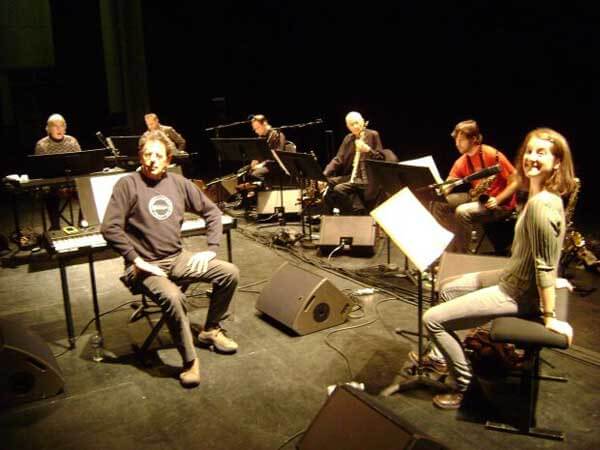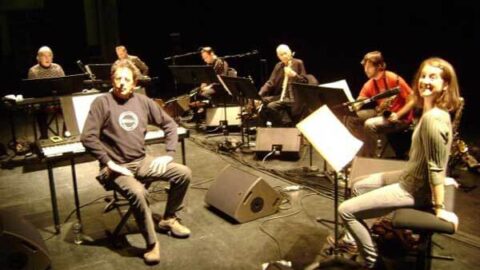 To some it was a rare experience. For fans of Philip Glass, attending a live performance of Koyaanisqatsi was one of the highlights of attending concerts in the London classical music scene this year. Koyaanisqatsi, the first installment of Godfrey Reggio’s film trilogy, was shown with Glass’ live music accompaniment at the Barbican on 14 December, 2012. Michael Riesman conducted the Philip Glass Ensemble, the Britten Sinfonia, and Trinity Laban Chamber Choir (directed by Stephen Jackson) in a newly expanded orchestral score by the composer for this European premiere. For the Glass Ensemble, Glass himself was on keyboards with Lisa Bielawa on vocals. Trinity’s Jeremy Birchall was the lead bass in the opening and closing credits, singing the famous title on low D.
To some it was a rare experience. For fans of Philip Glass, attending a live performance of Koyaanisqatsi was one of the highlights of attending concerts in the London classical music scene this year. Koyaanisqatsi, the first installment of Godfrey Reggio’s film trilogy, was shown with Glass’ live music accompaniment at the Barbican on 14 December, 2012. Michael Riesman conducted the Philip Glass Ensemble, the Britten Sinfonia, and Trinity Laban Chamber Choir (directed by Stephen Jackson) in a newly expanded orchestral score by the composer for this European premiere. For the Glass Ensemble, Glass himself was on keyboards with Lisa Bielawa on vocals. Trinity’s Jeremy Birchall was the lead bass in the opening and closing credits, singing the famous title on low D.

I was fortunate to see Powaqqatsi and Naqoyqatsi, the second and third films of the series, with live music by the Philip Glass Ensemble in 2006, at Davies Symphony Hall in San Francisco. Although disappointed at the time to miss the performance of Koyaanisqatsi, it was worth the six years’ wait to experience this unique and poignant piece live.
For the most part, the live performance at the Barbican was excellent, and truly unforgettable in comparison to watching and listening to the recorded version on TV or a computer. Glass’s well-known style of “music with repetitive structures” (I will hold back from labeling it with the “m” word) shone as a beacon with the hypnotic moving images on the screen. Some memorable moments included the choir singing over shots of two United Airlines Boeing 747 jets in close-up, bumper-to-bumper traffic on the California 405 freeway, natural desert landscapes in the American west, time-lapse photography of shadows of clouds moving across skyscrapers, fast-paced sequences of daily mundane life, and slow-motion scenes of stoic people during their daily commute in Manhattan. For the grimmer messages of the film, such as scenes depicting extreme poverty, pollution, and the perils of industrialization and urbanization on the environment, the film’s Hopi Prophecy bears a timeless message of warning: the 21st century civilization has received a wake-up call in this past decade about how we live. My colleague who joined me felt the piece depicts the vulnerability of humanity when we interfere with the organic flow of Mother Nature. Moreover, Glass’ iconic and magnetic score combined with this moving cinematic footage of “everything in life” was both memorable and fresh. Koyaanisqatsi still deserves to be known as a cult film of huge importance—a visual tone poem.

Although mostly beautifully revised for this performance, a few aspects of the new orchestration were a little discomforting. But these can be taken with a slight grain of salt if one is very familiar with the existing piece. At times the keyboards and electronics were so loud that it was hard to hear the choir. In addition, new detailed nuances like the electronics doubling the repeated D/A arpeggiated ostinato (flute or saxophone) were somewhat tiresome. An exception to the problems in the new orchestration: Glass’ revoicing of the harmonies in the choral part “Pruit Igoe” was a pleasing alternative to the soundtrack recordings (1983/2009 on Orange Mountain Music and 1998 on Nonesuch). Nonetheless, as a whole this event made a strong positive impression on the audience, as we were awestruck by the orchestra and at the same time glued to the images on the video screen.
It has been very exciting to partake in this year’s Philip Glass at 75 series at the Barbican. This was my second Glass performance at the Barbican, having attended the UK premiere of Einstein at the Beach in May. But unfortunately I was not able to attend A Forty Year Retrospective at Union Chapel the evening following Koyaanisqatsi. Glass returns to the Barbican from 10-12 May, 2013, to play his complete Etudes for Piano as part of A Scream and an Outrage series curated by composer and Glass protege Nico Muhly. As Glass is known for working in many types of media projects and collaborations, its no wonder that the Barbican fosters this groundbreaking relationship with him. After the excitement of Koyaanisqatsi, I am looking forward to many future Glass productions here in the UK.
–
Brian Mark is an American composer currently living in London.
























